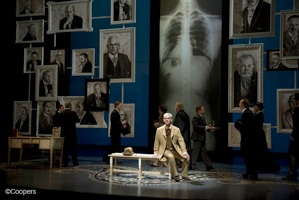
Workbook: The Doctors Dilemma
a workbook of sketches, ideas, and images for our Shaw Festival production of The Doctors Dilemma
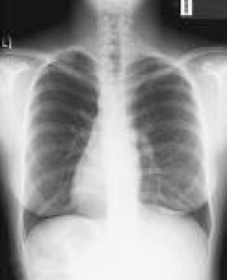
we are playing with the premise that some scientific data about disease can look a little like modern art, an idea that might nicely tie in with Dubedats profession, it would not be the first time art and disease made bedfellows. Below, a panel from the Aids Quilt project, at right a microscopic view of tuberculosis, left, a chest x-ray
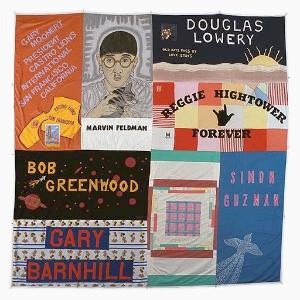
Van Gogh, Starry Night
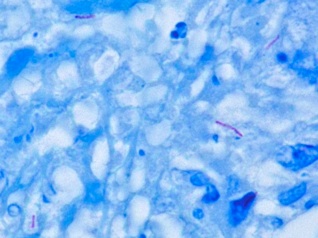
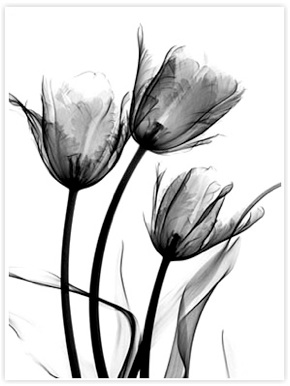
an xray of flowers, tulips maybe?
in our production of Habeas Corpus at Canadian Stage we used giant xrays.

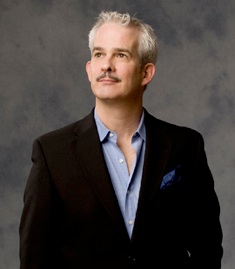
Patrick Galligan always cuts a dashing figure. He plays Dr. Ridgeon. Patrick played a doctor for us once before in Hotel Peccadillo. Below Krista Colosimo, playing Jennifer. Our first time working together, but Krista has done a number of seasons at the Shaw Festival
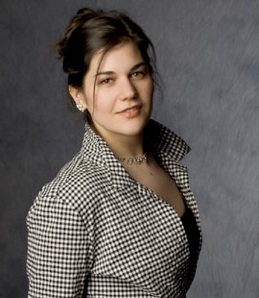
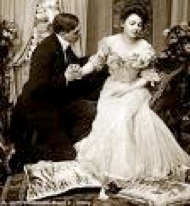
Victorian doctor tending to female patient. They even made suffering elegant.
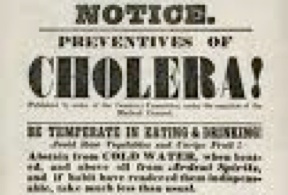
as serious as epidemics are today, none is as deadly as those of past eras, although we are no less hysterical. During the SARS scare, over seventy prospective producers, for instance, canceled their trips to Toronto to see our production of The Overcoat. Strangely, though, Colin Farrell showed up.
American Scientist has an erudite, detailed review of two recent books on John Snow, not the former secretary of the treasury but the doctor who solved the mystery of cholera in 19th-century London (spoiler: it was the water). Reviewer Christopher Hamlin likes the book okay but takes the authors to task for their presentism roughly, for praising Snow in hindsight for being right while demonizing his contemporaries who advanced theories that happened to be wrong.
Hamlin says that the scientific community wasnt ruled by folklore, superstition, and venality, as the books suggest, but rather that they had fairly reasonable, scientific paradigms that led them to disagree with Snow. For instance, other doctors criticized Snows theory because he simplistically assumed that the cause of cholera entered through the mouth because it caused problems in the gut. (Other theories at the time involved an inhaled pathogen.)
Seeing that modern medicine has shown that an STD cause body wide immune deficiency, that listening to a song help fix a brain dysfunction, and that a bacteria entering through the mouth and can change the entire culture of a country, this particular paradigm of Victorian medicine doesnt sound so backward.
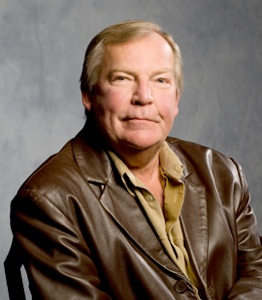

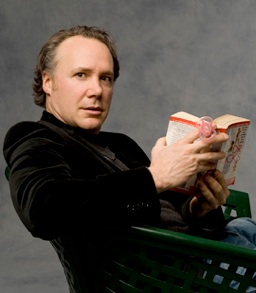
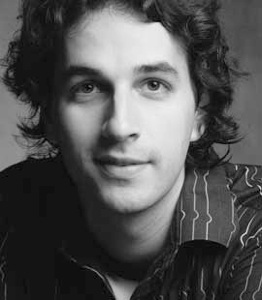
Jonathan Gould plays Dubedat, the artist
Three of our doctors, Thom Marriot, Patrick McManus and Michael Ball. Below, first xray in 1895, along with the inventor. Wilhelm Conrad Roentgen.






Some of the Charlotte Dean preliminary costume designs. Left Colenso Ridgeon, played by Patrick Galligan. The idea is to make him increasingly dapper as the play goes on, indicating an interest in improving his appearance, suggesting an increasing interest in Mrs. Dubedat. Left, a newspaper man, with an emphasis on lighter colours for the second scene of the play, left again, Dr. Ridgeon in his office. Lab coats are essential to play up the whole angle of medical research in the show. Right, the dashing Dubedat. Morris has asked that the character be almost Carnaby Street in fashion evoking both the Edwardian period and its odd, mod counterpart in the London 60s. Dubedat will appear to be not just in another world but almost in another time period giving him an ethereal and eternal quality. Left, Gustav Klimt inspired dress for Mrs, Dubedat, playing with ideas both of the period and of microscopic images of bacterial infection. At right, a more formal Dr. Ridgeon as he will appear at dinner in the second scene. All these sketches are preliminary, Many of the mens tuxedos will be found in stock and altered. Most of the building for the show will be for Dubedat and his alluring wife.






Set now being constructed at Shaw Festival, represented by very rough, preliminary models. At right large frames containing xrays which configure to make Dr. Ridgeon office in scene one. There is a morbid but fascinating aspect to xrays which also have an ethereal, ghostlike quality, suggesting something ephemeral and other worldly, a feeling we hope to capitalize on. Frame lower left is model for giant frame being computer build in giant proportions illustrated below. Ken has taken a prototype frame and given it to set builders who will scale it to a much larger size, and build it out of carved foam. The process requires very sophisticated computer programming which renders the original, rescale it to a much larger size where it can be formed. The frame, below, will be about twenty by thirty feet in dimension, and serve as a gigantic symbol of art and how it is contextualized.
More preliminary set models, this time at right, for scene three, which is called act three in the text, and which we are placing after the interval. This is a rendering of Dubedat studio, with enormous wall of windows at back, which flies in, a giant paint brush suspended as if it is painting on a canvas. The image on the canvas is that of a TB bacillus under microscope. Below a detail for the top of the studio window, which must be carved. A note to the technical director from Ken explains his drawing or at least tries to. In spite of planning and preparation, a lot of time and effort is spent in making adjustments to the design, for both practical and aesthetic reasons. However, the set construction begins sometimes months before rehearsals start, so there needs to be a pretty clear idea of what is being built. The models are equally valuable to the director, since once these sets are complete they cannot be changed. And so it is helpful to know, as near as possible, what the environment of the scenes will be for the sake of staging and, later, lighting.

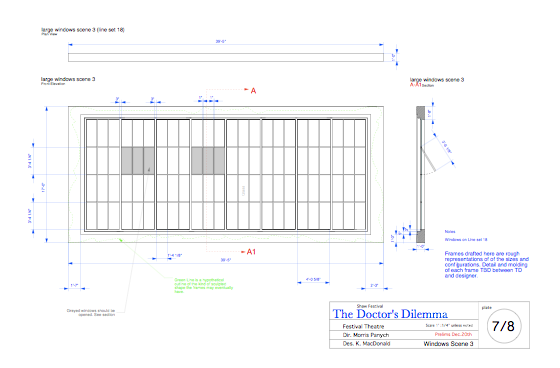

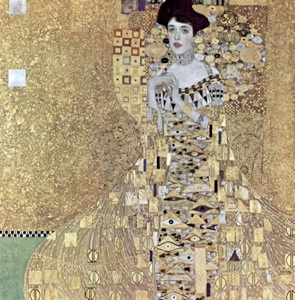
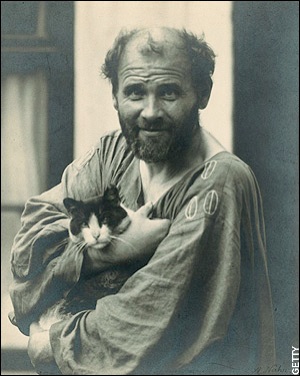
Left, a tuberculosis detail under microscope. Right, a painting by Gustav Klimt who is pictured below, right, holding a cat, and wearing his trademark crazy kaftan thing, which has inspired our look for Dubedat while working in his studio. Morris has asked Charlotte Dean, costume designer to give him a look that places him well outside the world of the rest of the characters in the play. Dubedat is an oddity and his own piece of work, who shamelessly borrows money, and generally lives the life of a reprobate, but also a life that rests in the hands of Dr. Ridgeon, whose ability to save Dubedat or not not, gives him a godlike status. It is in how he uses his godlike status that defines him. Some artists share this godlike status, but not because they can affect our mortality, but because they have become, through their work, immortal. Gustav Klimt is in many ways still with us. And where is his doctor?

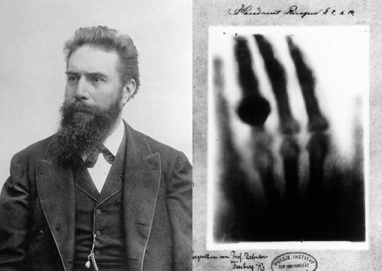
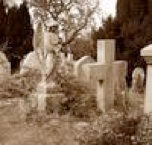
For the very poor, life expectancy was short; even for the rich, there were many health threats. At the beginning of the Victorian period, medical help was limited, whatever the budget. Life expectancy had declined in some cities as more people crowded in to find work.

The work of Pasteur and others saw epidemics and infections slowly begin to be brought under control. In the 1860s, French chemist Louis Pasteur showed that contamination in liquids (e.g. milk) was caused by microorganisms (e.g. bacteria) that could be killed by heat. Pasteur also realised that germs infected animals and humans too, leading to the identification and control of many diseases.
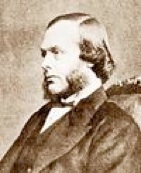
The use of antiseptics saw more people survive operations. At the beginning of the Victorian period, illnesses or injuries that needed surgery usually resulted in death from gangrene or other infections; then Joseph Lister suggested stopping the entry of germs by use of antiseptics.
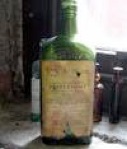
At the beginning of the period, many people had little faith in doctors. At the beginning of the Victorian period, only a few treatments were available to doctors and these had not changed very much since the Middle Ages. The same medicines (herbal cures, cod liver oil and purgatives) were given, regardless of the ailment. Diagnosis was poor.

First X Ray 1896
Our fear of death and the unknown means we give over a lot of our power to medical practitioners, whose ethics, we would like to believe, are at least as good as our own.
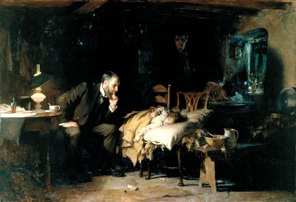
The Doctor (1891) by Luke Fildes. Is it our obsession with health or our fear of mortality that prompts us to give over so much power to doctors? Below, Fading Away by Henry Peach Robinson (1841). The truth is, we are fascinated and absorbed by anything we cannot control.
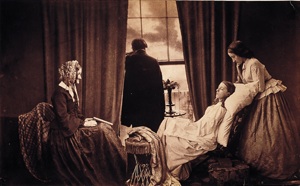

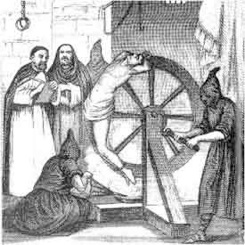
The history of Jews in England, as in most European countries, was not a particularly welcoming one. However, by Victorian times, although the community was small, it was thriving, which did nothing to stop Shaw from making weird obtuse and perhaps even racist references to them in this play, many of which have been expunged. Are we revising history by rewriting Shaw? Probably. A few years ago we removed odd and unwelcome references to black people in Noel Cowards Design for Living.
Back over at the shop, above, right, Paul shows us the layout of the large picture frame which has been manufactured from styrofoam from three dimensional state-of-the-art computer programs. Above, right. a giant pen, which will be suspended above Dubedats studio, also moulded out of styrofoam. Later these pieces will be painted with fibreglass to make them damage resistant. Left, the actors peruse costume sketches before hunkering down for a first reading of the play, an event fraught with nerves since nobody has heard either themselves or anybody else speak the lines before, especially with British accents. Below, detail corner of the moulded styrofoam frame.





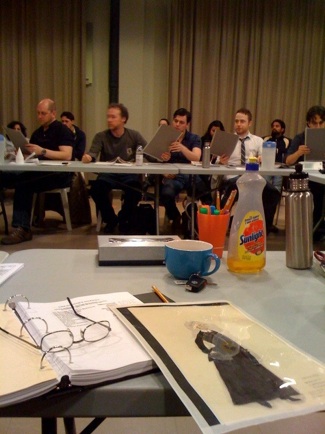
First day at Niagara on the Lake. Far right, Ken and Morris head for the shop where Leslie is waiting to show them the frames for giant Xrays. Paul and Leslie discuss with Ken some discrepancies in the moulded frame sent to them from the supplier in Calgary Below left, rehearsals begin with presentations from Charlotte Dean (costumes) and Ken, of course. It is customary at the beginning of rehearsals that people from theatre, marketing people, management people, and interested donors gathered to listen to a first reading of the play. Because the actors are in rep and acting in other shows, the schedule dictates that many of our rehearsals be in the evening, like this one.

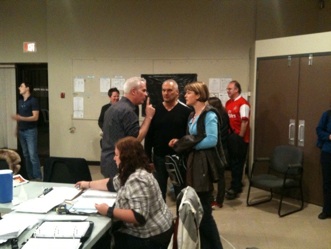

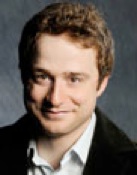





Catherine McGregor, Kelly Penner, above. Left, Ric Reid, Jonathan Widdifeild, Cherissa Richards, and right, Wade Bogert-OBrien, members of our outstanding ensemble. Above, preliminary sketches done by Ken for last scene in gallery, which he had decided to construct on his iphone but in the went for posed photographs, photoshopped on the computer with a program called coffee stain
Ken has begun to construct, with the help of his iphone the drawings of the doctors that will appear in the last scene of the play
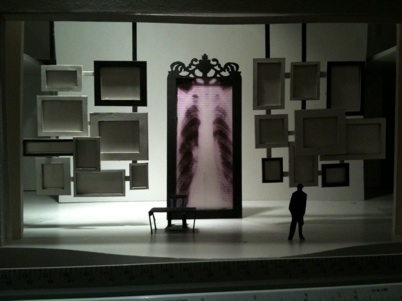




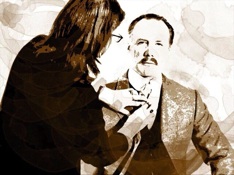

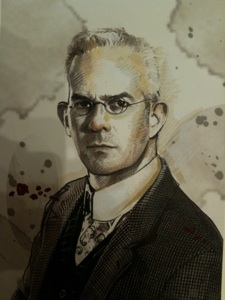
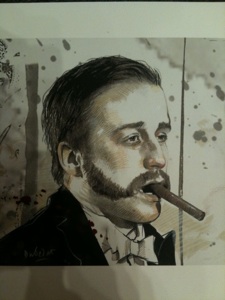
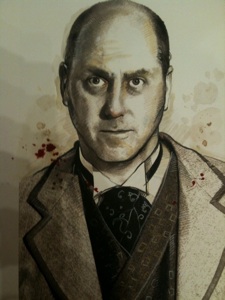

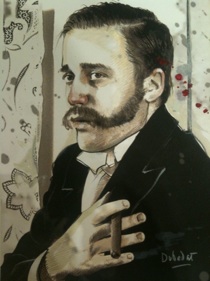
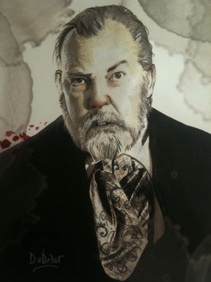
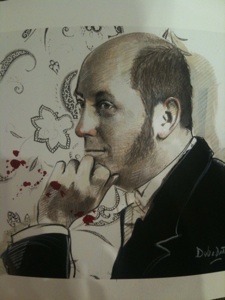
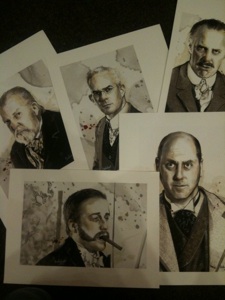
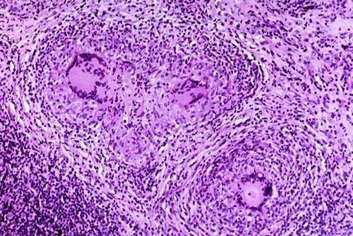
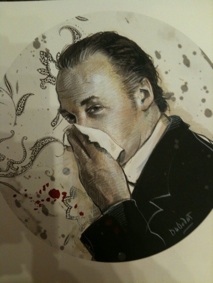
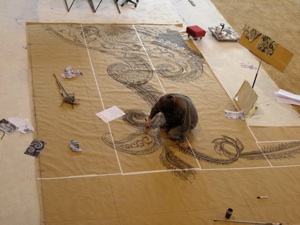
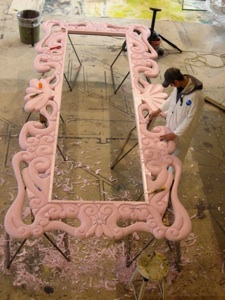
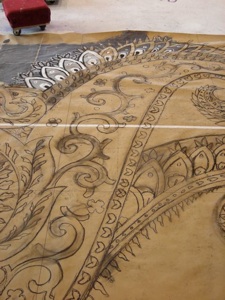
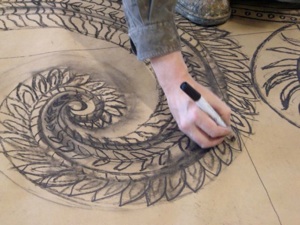
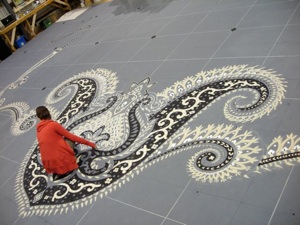
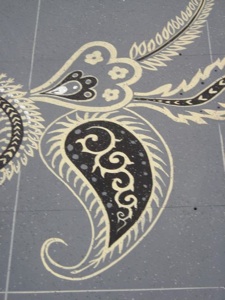
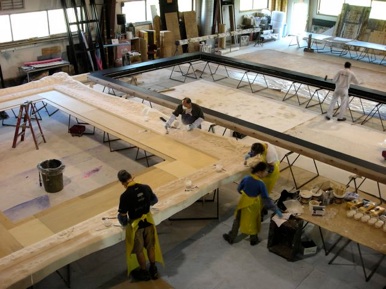
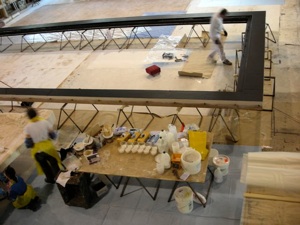
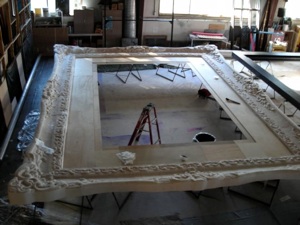
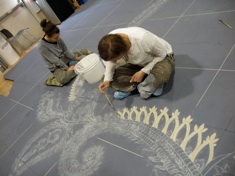
These are portraits of the doctors, which will appear in the gallery in scene five at the end of the play; we wanted to express the idea of mortality through these images, since through the doctors work Louis Dubedat loses his life but gains immortality
The portraits were taken from photographs of the actors, overdrawn by Ken so that they look not only like authentic portraits but also very skilled ones. Pictured, actors Marriot, Reid, Galligan, and above right, being prepared for his photo is Patrick McManus
Fabrics used in the show have a paisley pattern, very popular not only in Edwardian times but also the 1960s, a period from which we also borrowed our music and some of our costume design inspiration.
The microscopic image of a tuberculosis bacillus was an inspiration for the design of the show, in which we are trying to tie disease and art together in an interesting way. This image appears in the second scene, you cant miss it. Its twenty five by thirty feet in dimension.
More portraits of doctors, doctored by Anna in props and later Ken; shown above, left to right, McManus, Balll, Widdifield, and below them right, Marriot. Up left, another microscopic view of bacillus used for a painting in scene three, above; left preliminary sketches for paisley floor pattern, copied onto flooring, below. Below, centre, tip of giant pen. also from scene three, Dubedats studio. Painters in the paint shop make painstaking progress in realizing the magnificent floor patter, which is the Festival Theatre is seen by the majority of patrons and is, in some ways, as important an element in the design as any of the other visuals. and the reason Ken likes to watch the show from the balcony, of course.
Giant frames come together in the shop, up left the picture frame for scene two, molded by computer and dressed with fibreglass applied above, left a frame for the scene one xrays and beside it Steve Azza carefully carving styro into beautiful patterns for a picture frame.
Inspired by morality-free Dubedat, we are using the music of British 60s bad boys The Rolling Stones. As it turns out, and quite coincidentally, Mick Jagger loves Bernard Shaw and shares his birthday.

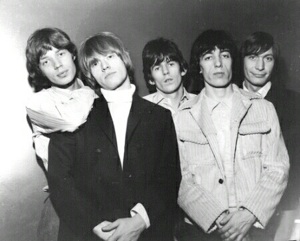
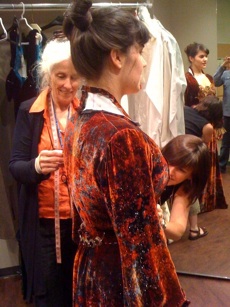
Krista tries on costume for the end of scene four, Charlotte peering from behind her in the mirror, above, right, ably assisted by the talented cutter Jill and first hand, Morgan.
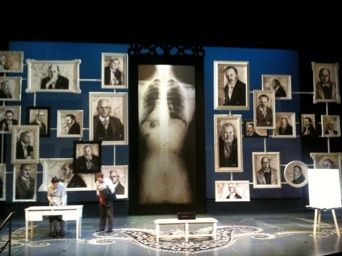
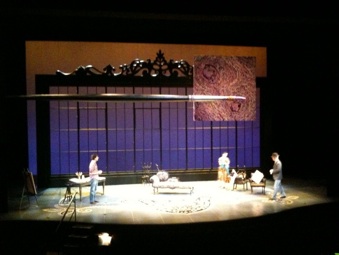
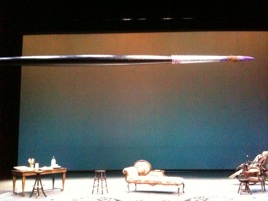
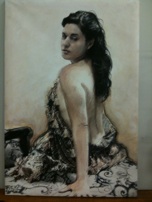

The set comes together onstage. Above, left, giant paint brush hovers over scene three, as, centre, Mrs, Dubedat poses for her husband. Below, left, the studio, right, the gallery complete with portraits of the doctors, who have survive Dubedat in life if not in reputation.
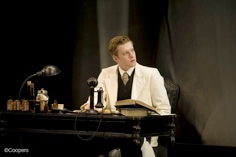
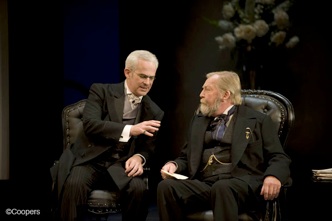
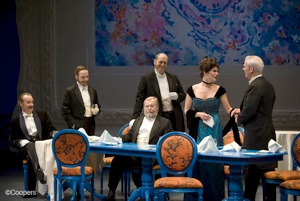
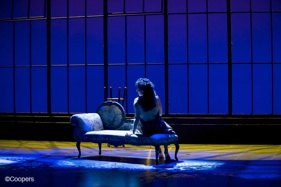
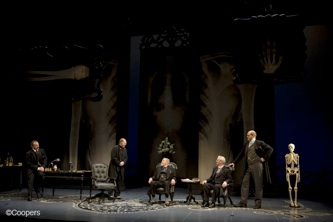
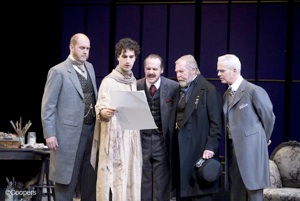
David Cooper production photos. Right, Ridgeon explains opsinin to Old Paddy Cullen, or at least tries to. To vaccinated a man without first knowing his opsinin index, he says, is murder, and idea he may take to later in the play. Below, left, Redpenny works on Ridgeon experiments, and below, right, the doctors gather to celebrate Ridgeons knighthood, or is it simply to pontificate and drink sherry at 10 am? So long as the dialogue is breezy and witty, and Shavian, who cares?
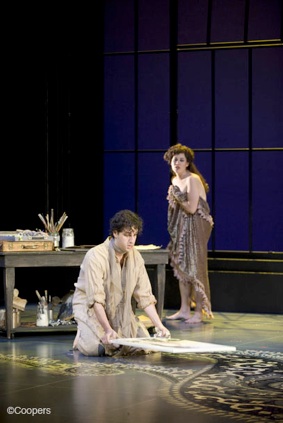
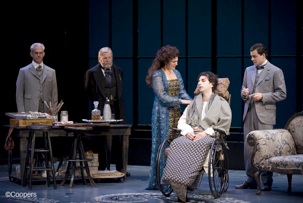
More production photos, courtesy David Cooper. Left, Mrs. Dubedat tries to convince the doctors to save her husbands life; right, she poses for Dubedat in the studio. Lower left, Dubedat auctions off a portrait, while the doctors, who have been pointing out his faults, find merit in his work. Below, right, Dubedat works on a painting of his wife while arguing about the relative merits of money. Below, left, Dubedat calls in the media for his protracted death, and lower left, a final scene in which Ridgeon is confronted with the futility of saving lives that have more value when they are over. Around him, a rogues gallery of doctors, portraits painstakingly recreated by Ken and the gang.
